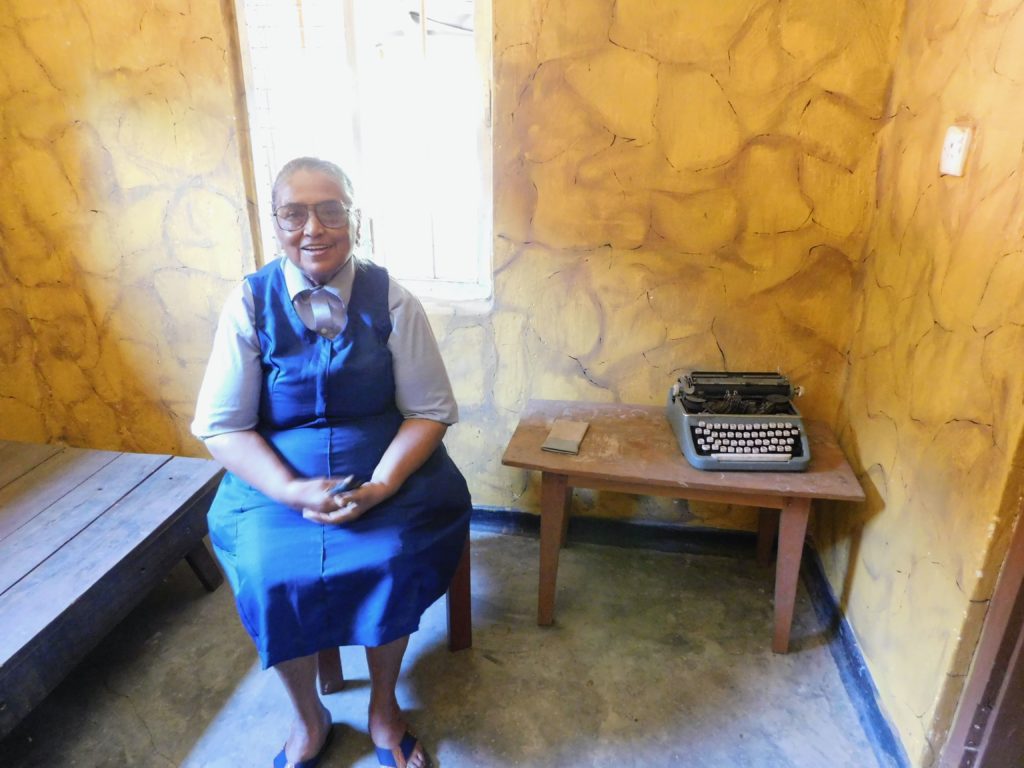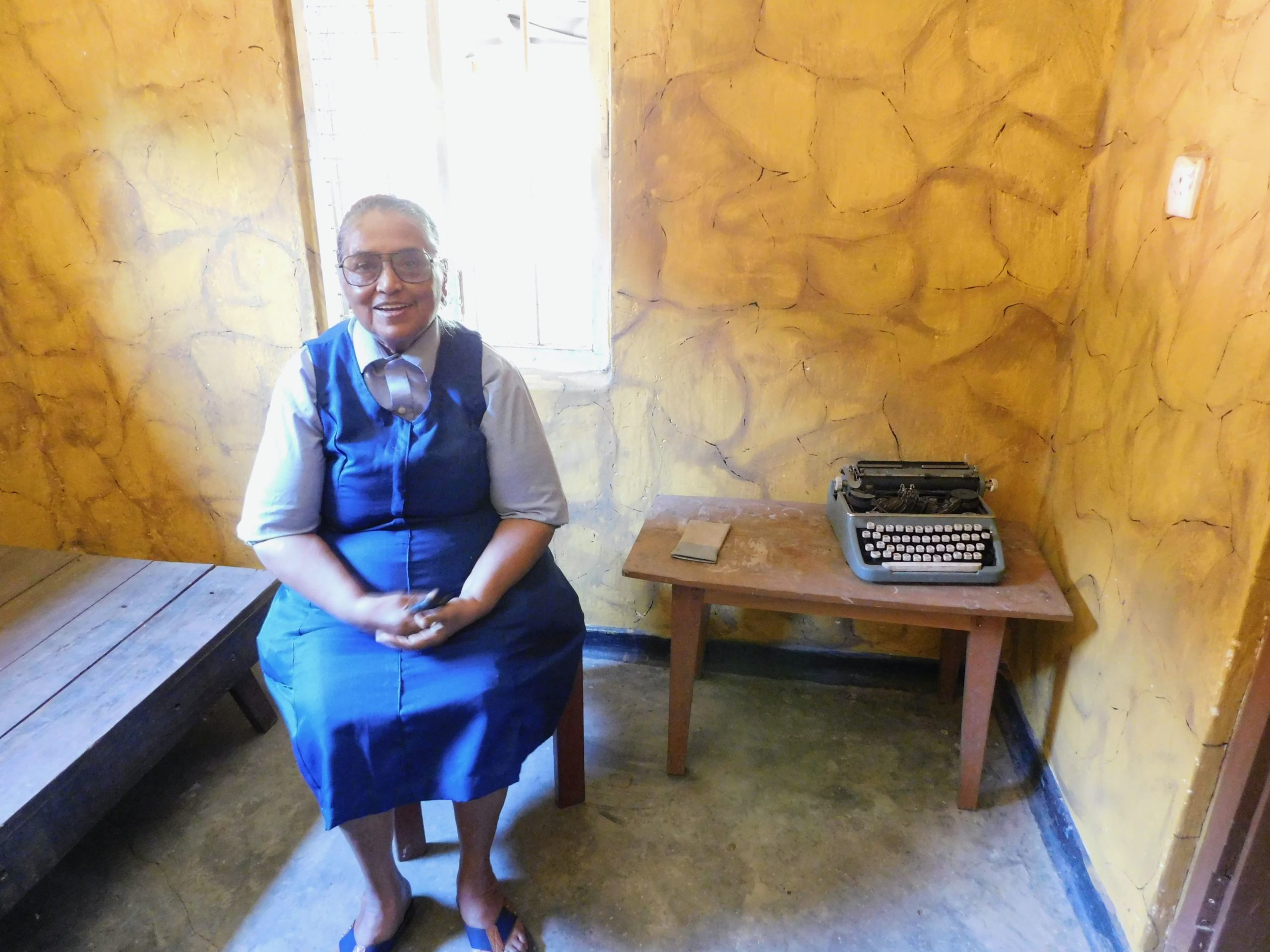Image Courtesy Kanya D’Almeida
When I began researching the life and work of Father Michael Rodrigo, a Sri Lankan Catholic priest who was murdered in the Uva Province in 1987, I was directed to a nun by the name of Sister Milburga Fernando.
No one knows more about Father Mike than she does, various people assured me. One afternoon with her will give you all the information you need.
I prepared for this meeting accordingly, dressing conservatively and reminding myself not to be too forthcoming about my views on religion. She was a Sister, after all, and an elderly one. I should be on my best behavior.
Little did I know that what began as a formal interview in a tea shop on York Street—midway between my home in Nugegoda and hers in Kerawalapitiya—would blossom into a loving friendship that lasted years. The last years, as it turned out, of Sister Milburga’s life. And even more surprising than the turn of fate that led us, briefly, onto the same path was my discovery that she was not the kind of “Sister” who cared two hoots about the clothes I chose to wear or even my critiques of the Catholic Church. Ideas that I had thought too radical for a seventy-something Sri Lankan nun (I never did learn her exact age)—ideas about politics, Marxism, spirituality and even sexuality—she not only understood but often shared.
I was pregnant at the time we met, temporarily on sabbatical from a career in journalism and social activism, and happily prepared for my six months’ remaining ‘confinement’ as some people called it—poised for two uneventful trimesters in the comfort of my home. But Sister Milburga turned those plans upside down. Sensing from our conversation that I was something of a kindred spirit, she enlisted me in a series of road trips that led me into cracks and crevices of Sri Lankan history I might never otherwise have been privy to.
First to Hatton, to a conference on the socio-economic and political issues plaguing communities of tea plantation workers, including the role of local churches and radical priests in drawing attention to their plight. It was here, in our shared room in a little hotel in the hill country, where she spoke at length about liberation theology, especially the revolutionary theological upheaval following the Second Vatican Council that took her to the village of Alukalavita in Buttala in the 1980s.
She had always told the story as though she was an insignificant character—how she and several other Catholics, determined to live out a doctrine of service to the poor, followed Father Michael Rodrigo into the heartland of the Sinhala Buddhist peasantry. It was a visionary project: to live among the poorest of the poor while building an interfaith community of fellowship, dialog and upliftment. Reams and reams have been written about the man who led this tiny exodus of people away from their urban comforts into a remote, rural village, where they eked out a living in thatched-roof quarters and ventured on foot from house to hut, documenting the struggles and lamentations of an entirely ignored population. But almost nothing has been recorded of his two stalwart sidekicks, Sister Milburga Fernando and Sister Benedict Fernandopulle, whose contribution to that mission and that incredible yet little-known chapter of Sri Lankan history became clear to me only when she recruited me on another journey, this time to Buttala.
It was, for her, a kind of pilgrimage—a bittersweet return after many years to a place where she had known tremendous joy before experiencing a tragedy. It was there, in the place they called Suba Seth Gedara, where Father Mike had been shot to death before her eyes while he performed the evening mass. Where she witnessed the murder not only of a man but along with him the demise of his beautiful plans for a better country based on justice for the farming community.
We spent the morning walking around the memorial erected in his honor, and the chapel—now a museum containing relics and photographs of Father Mike—where it all ended. But it wasn’t until we began our evening rounds of the villagers’ homes that I understood I was in the company of a person almost equally revered in that locality as the martyred priest himself.
Every person who came to the door to greet Sister Milburga got down on their hands and knees in a gesture of respect so genuine, so filled with love, that it brought tears to my eyes. Although I had come here to record their testimonies about Father Mike, each family had as much to say about the two faithful nuns who had stood beside him. Like old friends they began to reminisce about the time the strange contingent of Christians turned up in this dusty, predominantly Buddhist village, and how they set about shedding their vestments and their city ways and building solid ties with their neighbors. I was quite forgotten as the conversations meandered through a time they all held close to their hearts. The interviews ended in tears, not only of sorrow but of gratitude. Because the lessons imparted at Suba Seth Gedara—the printing of a magazine pertaining to rural affairs, the English classes offered to the youngsters (now grown, with families of their own), the creation of a village library, the festivals, and above all the sense of dignity instilled in them—had changed the course of their lives. And that gratitude extended not only to Father Mike, but equally to the two women, his Sisters-in-Arms.
There are people who make headlines. Who have books written about them, and are memorialized long after they’re gone. And then there are those who live, not in the shadows but in the footnotes, visible only to the precious few who go looking for them. Sister Milburga was such a person. In countless accounts of Father Mike I found her name in the acknowledgments, always given special mention as a particularly rich source of information about a murder for which no perpetrator has yet been brought to book. And on this journey for justice, Sister Milburga has been, not alone (for there have been many others who have walked with her in search of answers) but certainly lonely. In the vast vacuum left by the Sri Lankan authorities and certain institutional arms of the Catholic Church—all of whom neglected to launch any credible inquiry into Father Mike’s foul murder—she stepped in as a kind of solitary detective, a stenographer and a scribe. With almost no resources at her disposal beyond her own grit, she trekked back through history and painstakingly pieced together one of the most comprehensive collections of Father Mike’s work. Anyone wishing to understand why a peaceful, beloved, barefoot priest was shot in cold blood in daylight for all to see need only consult her book, ‘The Harvest Dream of Father Michael Rodrigo, OMI’, which lays bare all the social, economic and political realities of the time, channeled through the lens of Father Mike’s unshakeable faith in God and the goodness of humankind.
In the months and years that followed I badgered Sister Milburga to allow me to write about her life. I had borne witness to the pride of place she occupied in this story and I was tempted to ignore her strict instructions that I confine my writings to Father Mike and his living legacy. Once or twice I threatened to send some photographs I’d taken of her on our travels to a newspaper, along with a write-up extolling the many anecdotes, the little victories and the quiet sorrows, that make her life worth remembering, worth celebrating. She was living in my house at the time, having come for a short visit on the eve of the first, extended lockdown in 2020, and found herself stuck with no means of returning home. She responded with her mischievous grin, the kind that seemed to transform her into a little child, and admonished me for even suggesting such a thing. No matter where my incessant questioning might lead us, usually into the intricacies of her life’s story as a woman in the church, we always returned, at her insistence, to Father Mike.
Tonight, having learned of her passing only hours ago, I am flouting her wishes. It is right, I think, to celebrate her at long last with a larger audience than the one she would have sanctioned. I like to think that the rebel in her would forgive my small transgression, and that the saint in her will bestow upon me her signature smile, as she did so many times throughout the course of our short but very dear friendship.

